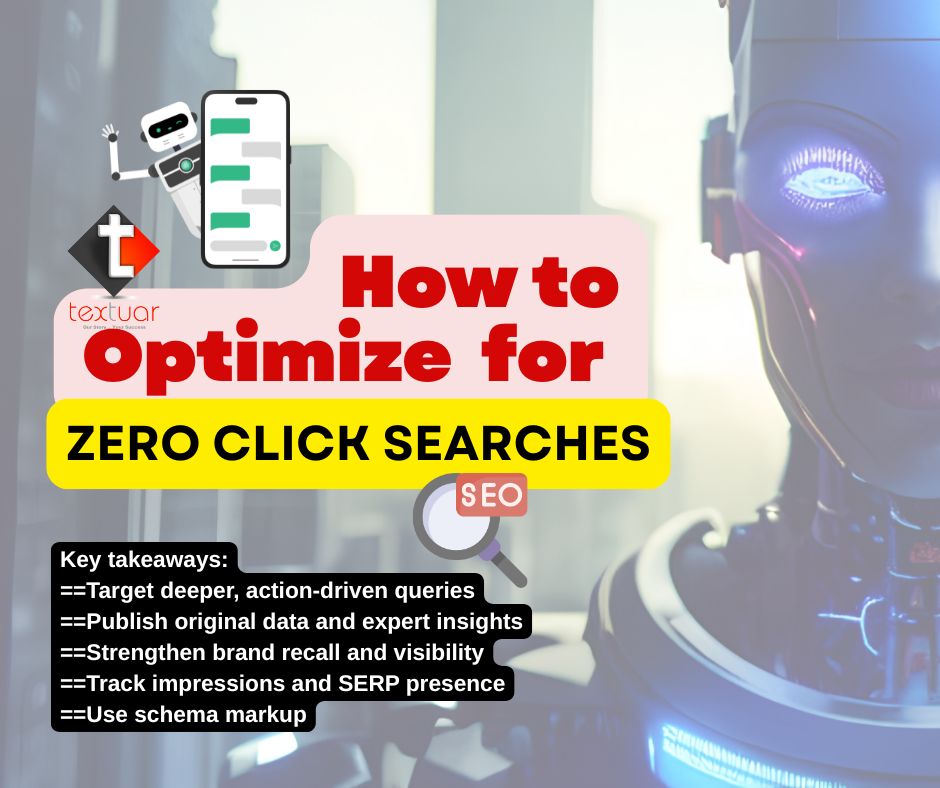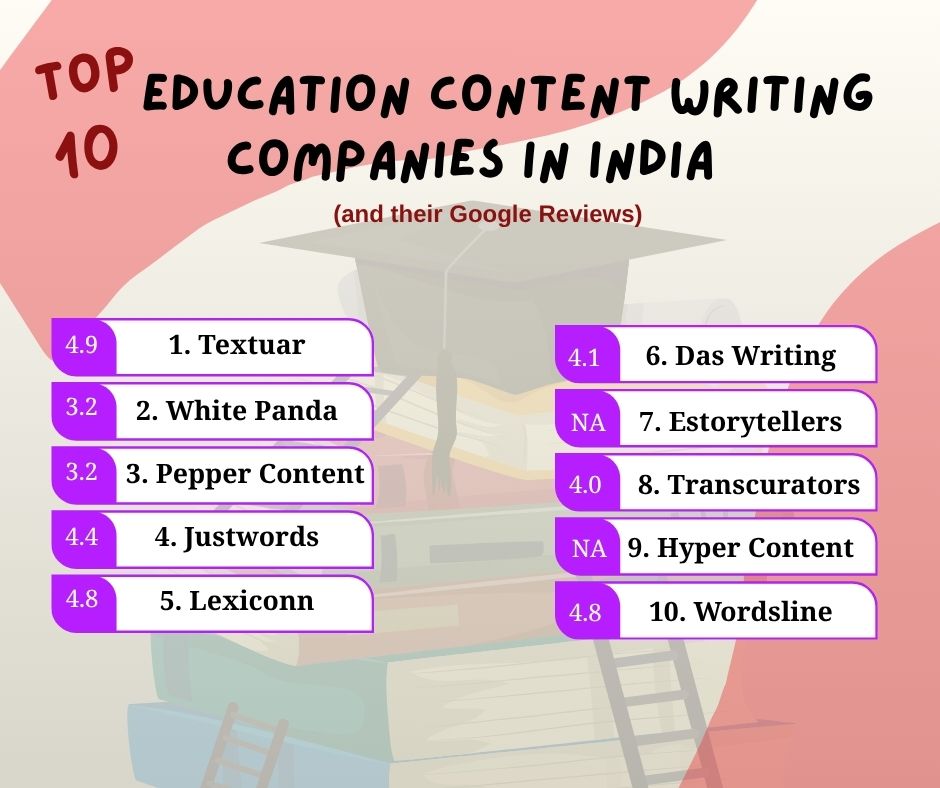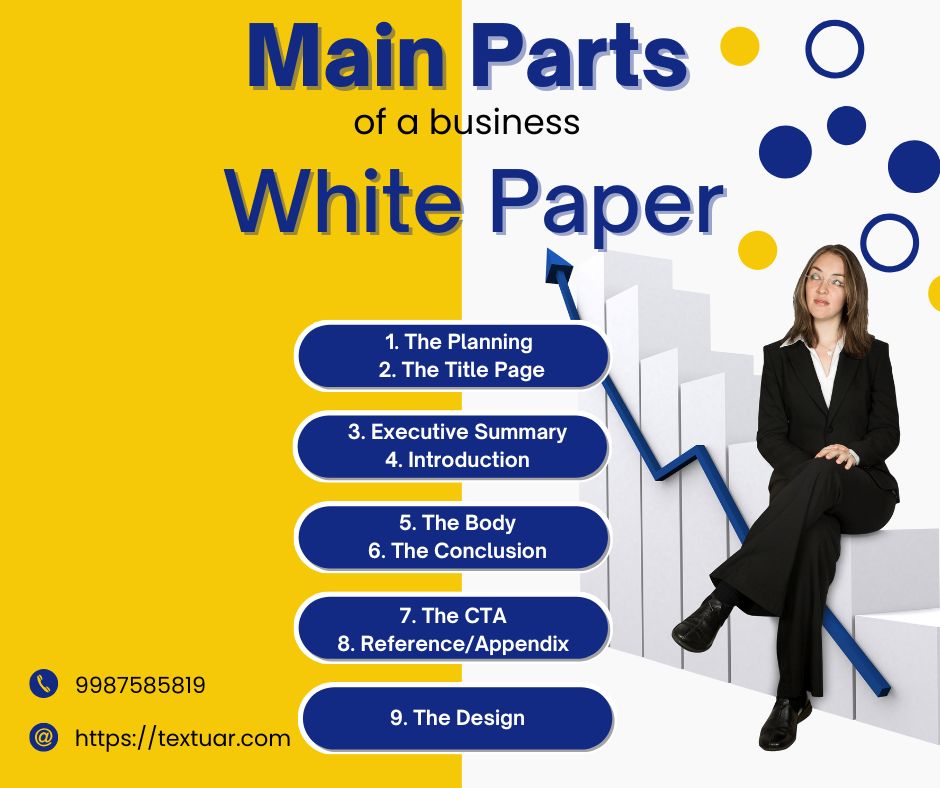A few years ago, content marketing was easy. All you did was write for Google, optimize your keyword and build as many links as possible. That did the job back then. However, those days are now starting to look numbered.
Generative AI tools have revolutionized everything. People now ask ChatGPT rather than Google searches.
This change has been enormous for brands. Just like zero-click searches, people can now get answers on tools like ChatGPT and Claude. They need not visit the site anymore.
Perhaps, this explains why your older SEO strategies will cut it anymore. You require new strategies like LLM content marketing to get through to your audience.
Why is this important? Because your customers are altering the way they access information.
They are now relying on AI tools more and more every day. If you aren’t prepared, you’ll lose these prospects to those who are. Therefore, this guide teaches you how to adjust. You’ll know what LLMs are searching for. You’ll find out how to write content that AI tools suggest. Above all, you’ll get ahead of the curve as an AI company.
How LLMs ‘Get’ What We Want as Responses
LLMs derive answers from two primary sources. The first is training material like guides, articles, and other written content used to instruct the AI. The second is live web searches.
When you question ChatGPT, it analyses your query first. It determines what you actually want to learn. After that it goes on the web and looks for new information. Then, it integrates all of that into a useful response.
Here’s how this differs from Google. LLMs don’t simply give you links. They read for you. They extract the highlights. Then, they only give you what’s important.
The process is referred to as RAG (Retrieval-Augmented Generation). Imagine having a clever assistant who reads it all and provides you with the summary.
So, what sources do LLM training models rely on most? They like Wikipedia, Reddit, and reputable news websites. Also, certain review websites, such as G2 and Capterra, are preferred too. Plus, well-transcribed videos on YouTube rank higher as well.
Finally, the key takeaway here is simple. LLM and AI training models prefer spick-and-span, structured data. They avoid fluff and insist on it. Facts. They seek content that answers user queries directly.
So, this implies that your content is going to have to shift, you can no longer write for Google. You must now also consider how AI tools will read and interpret your content.
How to Optimize Content for LLM and AI training
Developing content for LLMs is a different ball game. Here are the key principles you must adhere to.
| Principle | Action Steps | Why It Works |
| Concise, Factual Text | Cut filler words; every sentence must serve a purpose. | LLMs prioritize clear, direct information over fluff. |
| Neutral Tone | Avoid hype/sales language; write like a helpful expert. | Promotional content is demoted by AI models. |
| Structured Format | Use headings, bullets, FAQs, and tables. | LLMs scan structured content faster and extract key details. |
| Answer First | Place critical info upfront; use clear question-based headings. | Matches how users query AI tools (direct questions). |
| Natural Language | Write for voice/search queries (e.g., “How to X” vs. “Best Practices”). | Aligns with how people phrase prompts in ChatGPT/Claude. |
| Original Data | Include research, expert interviews, or case studies. | LLMs favor unique data over repetitive web content. |
| Plain Language | Avoid jargon; write for real users with real problems. | Training datasets are built for general audiences. |
Let us learn a bit more about them:
1. Write Concise, Factual Text
Each sentence must serve a purpose. Cut out filler words and extraneous descriptions. Remember, vagueness confuses the LLM and AI training models. Instead, they like clear, factual statements.
So, before posting anything, question yourself: “What exactly does this fix?” If you can’t relay the information concisely, rephrase it.
2. Maintain a Neutral Tone
Stay away from hype and sales talk. LLM and AI training models demote content that reads too much like a sales pitch. Hence, try to act as a helpful expert, not a needy salesman.
Rather than “Our great software transforms everything,” use “This software enables teams to work on projects more effectively.”
3. Use Structured Elements
Organize your content with bullets, headings, and tables. This means also including a summary above or writing FAQ sections. This makes your content easier for both humans and AI to read.
LLMs are fond of well-structured information. They can scan structured content quickly and extract meaningful facts.
4. Answer Questions Promptly
Place important information at the start of your articles for LLM content marketing. So, do your best to avoid having readers search through paragraphs for answers. To achieve this, use clear headings for common questions.
5. Fit Common Triggers
Consider the way individuals ask questions to AI tools. They tend to be specific and straightforward. So, create content for AI that fits these natural language patterns.
For instance, rather than writing an article “SEO Best Practices,” write “How to Optimize Your Website for Search Rankings.”
5. Include Original Data
The web has too much boilerplate content. Therefore, in order to get noticed, add new research, facts, or interviews with experts. These are the sort of things that LLMs appreciate a lot: new, original information. Hence, it will positively affect LLM content marketing.
6. Use Plain Language
Don’t write for other copywriters or SEO experts. Instead, you must write for actual people with actual issues. Don’t use technical terminology or industry slang. Most LLM training datasets are designed to assist normal users, so plain language is more effective.
What Types of Content Increase LLM Visibility?
Certain content forms are more suitable for use with LLM content marketing than others. Optimize these forms to increase your visibility.
1. Definition Pages
Build “What is [X]” pages for key terms in your niche. Here, you can begin with a single-sentence definition. Then, you can follow that up with in-depth explanations and examples.
These pages are meant to reply to straightforward questions that users pose to AI tools, which, in turn, makes them ideal to add on traffic from inquisitive users.
2. Comparison Articles
You can also write in-depth comparisons of products, services, or ideas for LLM content marketing. This means organizing information using tables. Plus, you can also mention the pros and cons for each.
LLM models like comparison content as it assists users in making informed decisions. Moreover, this content tends to rank high in AI responses.
3. Best Tools Lists
This means building lists of suggested tools or resources. You must organize them with concise headings and bullet points. Additionally, you must describe why each tool is essential.
Also, ensure these lists get revised frequently. New information is given more importance by LLM and AI training models.
4. Product-Focused Content
If you’ve got a product, discuss its features and the benefits when planning LLM content marketing. Try to emphasize how it solves the reader’s problems. To do this, you can incorporate schema markup to enable AI tools to better comprehend your content.
Don’t merely enumerate features. Describe how every feature serves users in practical situations.
5. Case Studies and Reviews
Share real customer stories and detailed reviews. These provide unique insights that LLMs can’t find elsewhere. Plus, they also build trust with potential customers.
Therefore, focus on specific results and measurable outcomes. Numbers and facts work better than vague success stories.
6. Research-Based Articles
To get more attention, you can publish original research findings and industry statistics. This type of content establishes your authority and provides valuable data for AI tools to reference.
Surveys, studies, and trend reports are particularly useful as they provide new insights.
7. Video Content with Transcripts
You should make YouTube videos with precise transcripts, descriptions, and clear titles. This is because LLM and AI tools are now able to read video content, so this is an important format to have.
Plus, on YouTube, you can easily make educational content that answers particular problems. Even tutorial videos do very well for LLM content marketing.
Connect with Textuar to know more about how AI content services can boost your presence on LLMs.
How to do Off-Page Content Optimization for LLM Discovery?
Your content strategy doesn’t end with your website. LLMs draw facts from numerous places all over the web. Here’s how to maximize your overall online presence.
1. Third-Party Listings for LLM Content Marketing
List your business in related directories and review sites. This helps keep active profiles on sites like G2, Capterra, and industry-listing directories.
You can even ask happy customers to provide detailed reviews. Also, engage with all feedback professionally and promptly. This will keep your profiles fresh with up-to-date information.
2. Wikipedia and Knowledge Bases
If your product or company is a huge player in the space, you should write or even enhance Wikipedia articles. LLMs pick from such credible sources and present them to users as relevant answers to their ChatGPT queries. However, stick to their rules, meticulously link to credible sources and stay neutral.
3. Community Participation
To achieve a more involved image, join discussions on Reddit, Quora, and industry forums. Such targeted LLM content marketing will help you provide helpful answers without being promotional. Share your expertise genuinely.
LLMs often reference these community platforms when answering user questions. Hence, even your little helpful contributions can boost your visibility.
4. Utilise Structured Data
You can even use schema markup for your sites. This way, you can better use your product features and make instructional content to help AI tools understand your business better.
This structured data acts like labels that tell LLMs exactly what your content is about.
5. Be Consistent in LLM Content Marketing
Keeping your brand name, product name, and key messages consistent everywhere is quite important. This includes your website, social media, press releases, and third-party listings.
Inconsistent information confuses LLMs and can hurt your visibility.
6. Optimize Knowledge Panels
Claim and optimize your Google Knowledge Panel. Also, submit corrections through Google Search Console when needed. The reason why is that this information often feeds into other AI systems.
7. Create Content Clusters
You should structure your content around distinct topics to train your LLM model. Connect similar articles to each other. This helps enhance your authority in your specific field.
Also, strategically employ internal linking to indicate the connection between your content items.
8. Author Credibility in LLM Content Marketing
With detailed author bios, you can boost your content. On top of that, even highlight relevant expertise and credentials. This helps establish trust with both readers and AI systems.
Make sure author information is consistent across all your content.
How to Enable Effective Content Strategy to Suit LLM Performance
The advent of LLMs demands strategic adjustments to your existing content strategy. Here’s how to make the shift to more effective LLM content marketing.
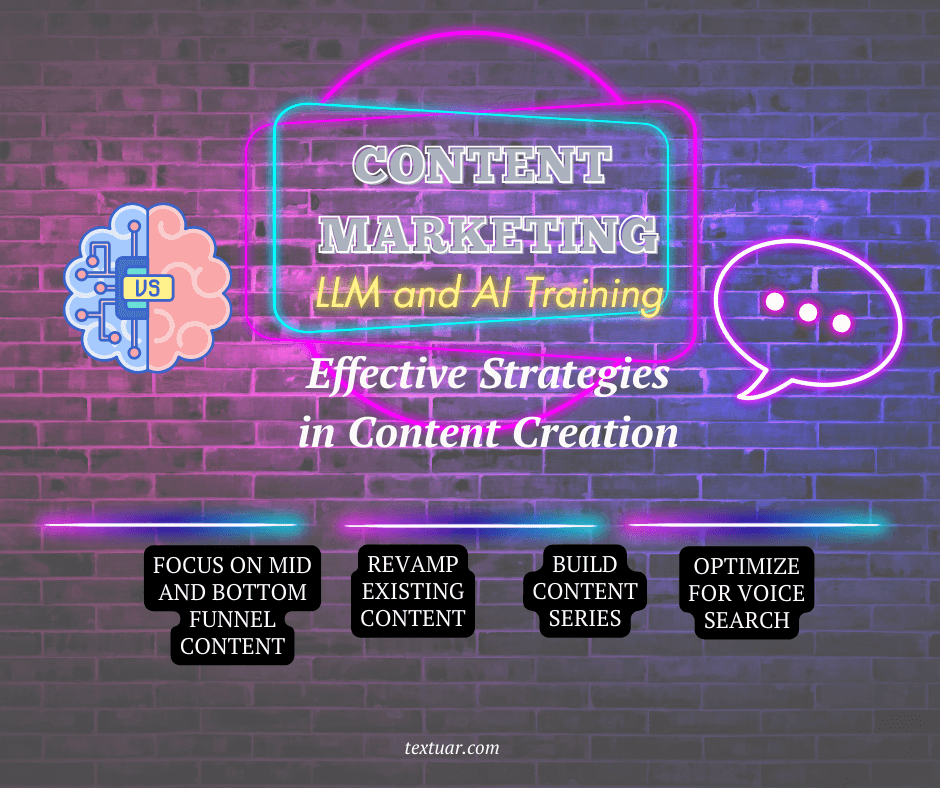
1. Prioritize Mid and Bottom Funnel Content
Top-of-funnel content tends to receive cookie-cutter AI answers. This means customers may not have to come to your site for simple information.
Rather, you should pay attention to comparison guides, how-to instructions, and solution-based content. Having content like this aligns with buying intent and captures qualified traffic to bolster LLM content marketing.
2. Revamp Existing Content
Regularly audit your existing content. Also, keep on adding new data, enhance structure, and correct outdated facts. Remember that new, up-to-date content works better with LLMs.
Therefore, focus particularly on stories that previously ranked well but no longer get traffic. Believe it or not, in many cases, minor updates can revive your content.
3. Build Content Series
Build authoritative guides that treat subjects exhaustively. This means addressing the difficult topics in your field through associated articles. Then, you must connect these articles with one another to form distinct learning paths for your readers.
4. Optimize for Voice Search for LLM Content Marketing
LLMs commonly help voice assistants with queries. So, produce content that responds to questions using a natural, conversational voice. This makes employing natural language flows that mirror the way humans speak.
For better results, consider long-tail keywords that resemble genuine questions.
How to Track and Measure Your LLM Content Impact
Monitoring LLM performance differs from standard SEO metrics. Here’s what to measure.
1. Test AI Responses
You must test ChatGPT, Perplexity, and other AI tools regularly with prompts. Also, check if your content shows up in the responses. Plus, take note of what does work and what doesn’t.
This will help you develop a keyword list of significant keywords and questions about your business. However, test them each month to monitor their progress.
2. Track Referral Traffic
Configure your Google Analytics to monitor traffic from AI platforms. This works by searching for referrals from chatgpt.com, perplexity.ai, and other such sources.
Also, build individual segments to segregate this traffic and monitor user behaviour.
3. Monitor Brand Mentions
Employ tools such as Brand24 or Google Alerts to track mentions on the web. It helps you keep an eye out for what happens with your brand, whether it is being talked about on Reddit, Quora, or other discussion boards.
These mentions have a significant impact on what LLMs display about your business.
4. Quality Over Quantity
Optimizing for LLM content marketing is less about quantity and more about quality. Therefore, prioritize making fewer quality pieces of content instead of posting regularly.
Plus, keep an eye on engagement metrics such as bounce rate and time on page. These reflect whether or not your content actually assists users.
What are the Common Mistakes to Avoid in Optimizing Content for LLMs?
Optimization for LLMs involves learning how to avoid pitfalls. Here are the largest mistakes to be on the lookout for.
1. Over-Optimizing for Google
Avoid neglecting LLM readability while pursuing Google rankings. The ideal strategy balances both demands. So, write for humans initially and then optimize for search engines.
2. Creating Gated Content
LLMs are not able to read content behind paywalls or email gates. That is why always share your in-depth expertise if you desire AI tools to suggest it.
3. Being Too Sales-Focused
Heavy promotional language damages your credibility with LLMs. Hence, you should concentrate on assisting your audience instead of generating immediate sales via LLM content marketing. Having educational content tends to convert better in the long term in any case.
4. Ignoring Off-Page Presence
Avoid concentrating exclusively on your website. You must simultaneously establish your presence on applicable platforms and communities. This builds a full picture for LLMs to base their responses upon.
5. Anticipating Rapid Results
LLM optimization is a slow process. Therefore, don’t shift strategies every few weeks. Stay with your strategy and track progress over the course of months, not days.
6. Neglecting Technical Issues
Ensure your site loads fast and is viewable on mobile. Having such technical issues might block LLMs from seeing your content in the proper way.
The Future of Content Marketing Is Multi-Platform
Content marketing is getting more complicated but also richer in opportunity. It requires you to present yourself on many channels and formats.
LLM content marketing has not supplanted traditional search engines. Instead, they have merged with them. In the case of Google, it employs AI in its search results, whereas Bing drives various chat interfaces.
This implies that you must have a plan that benefits both traditional SEO and LLM optimization. However, the best part is that most best practices exist within the overlap.
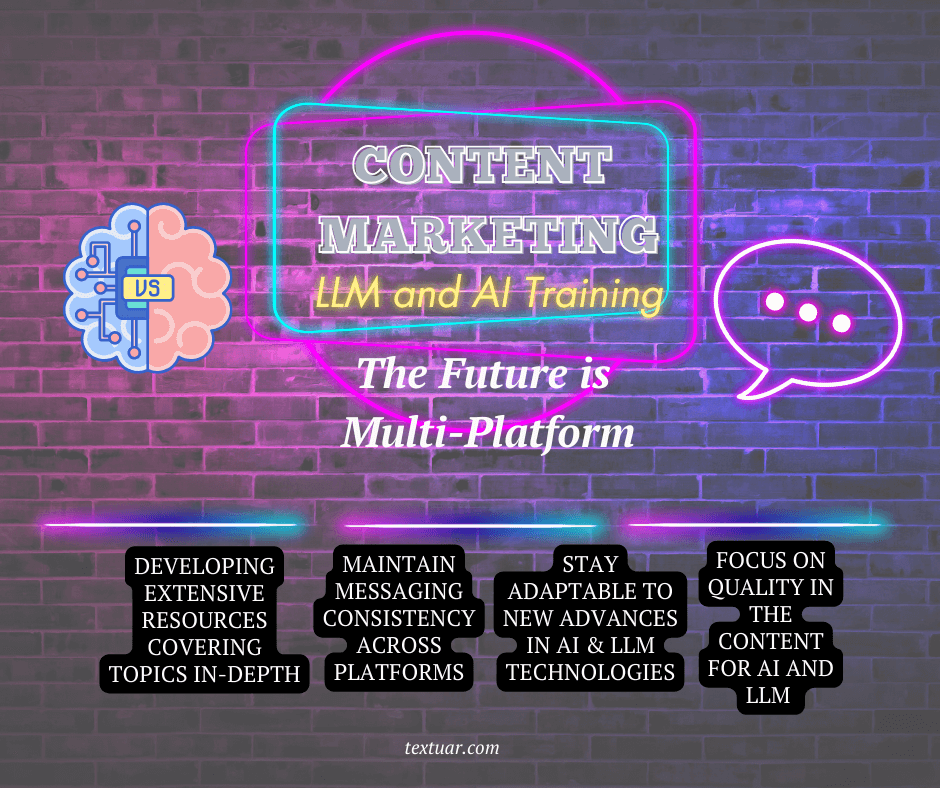
1. Create Content Ecosystems
Think in terms beyond single articles. This means developing extensive resources covering topics in-depth. This includes things like blog posts, videos, social media posts, and community engagement.
2. Maintain Consistency
It is essential to ensure that your messaging is consistent across every platform. This makes LLM and AI training models aware of your brand and gives them the right information about your company.
3. Stay Adaptable
The world of AI and LLM training is dynamic. You can expect new technologies to appear every few weeks. Therefore, it is vital to keep yourself updated on such advancements and make necessary adjustments.
4. Focus on Quality
With so many resources online, quality is more important than ever. So, focus on building assets that actually assist your users. This strategy works for any algorithm or AI system.
Wrapping Up
AI and LLM training models are altering the way people discover and access information. This change presents challenges and opportunities for content marketers alike.
However, the solution is understanding how these AI tools process your content. They appreciate plain, factual, logically ordered content. Also, they like credible sources with consistent facts.
Hence, in order to succeed, you must have a multi-platform strategy. So, optimize your website content while establishing your visibility throughout the web. You can even join communities, keep directory listings updated, and produce shareable documents.
Keep in mind that LLM content marketing is a long game. Results don’t pop up overnight. Just make content that is actually helpful instead of attempting to game the system.
In the end, the winning brands will be the ones who are early adopters. So, begin incorporating these strategies today. Connect with Textuar to know how you can make your brand be present on LLMs and AI tools.
LLM Content Marketing – Frequently Asked Questions
Q- What types of industries reap the most benefits from LLM content marketing?
SaaS, healthcare, fintech, and e-commerce gain the most from LLM content marketing. All these sectors have high content requirements and leverage AI-driven personalization and scaling of content creation.
Q- What are the primary risks of applying AI for content creation?
The largest risks are the dissemination of false information, the generation of generic content, and the excessive use of AI without human supervision. Therefore, you must always fact-check AI-created content and incorporate your own voice.
Q- What trends should I be monitoring in AI-driven content marketing?
Some of the most prominent trends are multi-format content generation, prompt optimization, and proper integration of analytics tools. These are the reasons why most brands are phasing toward AI-aided workflows instead of complete automation.
Q- How do I approach ethics in using AI for marketing content?
Start by being clear about using AI for purposes pertinent to your task. Steer clear of information manipulation and generating deceptive content. Plus, use useful, precise information that instils trust in your audience.
Q- Which LLM platform is most valuable for content marketers?
ChatGPT and Claude are presently ahead on quality and flexibility. Perplexity shines when it comes to research work, whereas Google’s Gemini plays well within search routines. So, pick according to your unique needs and budget.


